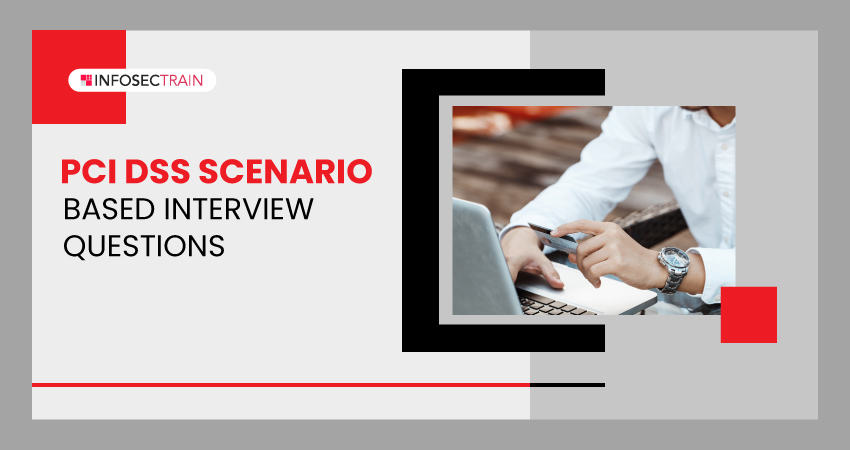PCI DSS Scenario-Based Interview Questions
In the realm of cybersecurity and data protection, PCI DSS (Payment Card Industry Data Security Standard) plays a pivotal role in ensuring the secure handling of payment card transactions. As organizations strive to maintain PCI DSS compliance, they seek individuals with a deep understanding of its principles and practical application. To evaluate individuals’ proficiency in PCI DSS, scenario-based interview questions have become an essential tool.

This article delves into the world of PCI DSS scenario-based interview questions, offering valuable insights into the top questions and effective answers you need to navigate this essential aspect of hiring for PCI DSS compliance roles. Whether you are an interviewer seeking to assess a candidate’s expertise or a job seeker preparing for a PCI DSS interview, these scenario-based questions will shed light on how to tackle the challenges posed by PCI DSS compliance in the real world.
PCI-DSS Scenario-Based Interview Questions
1. An organization is launching a new online store. How would it ensure PCI DSS compliance?
- Engage a Trusted Payment Processor: Partner with a payment processing provider that adheres to PCI DSS standards, ensuring that payment data handling is entrusted to experienced professionals.
- Fortify Access Controls: Establish rigorous access control protocols within your online store’s systems, limiting access to authorized personnel only and enforcing strict authentication measures.
- Continuously Monitor and Test: Maintain an ongoing process of monitoring your network for security threats and regular testing and vulnerability assessments to address weaknesses proactively.
- Secure Stored Data through Encryption: Safeguard cardholder data by encrypting it when stored, making it indecipherable to unauthorized individuals or cybercriminals in case of a breach.
- Educate and Train Staff: Equip the staff with comprehensive training on security policies, ensuring that they comprehend and adhere to the organization’s security practices for protecting sensitive payment information.
2. How should PCI DSS compliance be handled while processing credit card orders at a branch employing paper-based forms?
- Go Digital: Switch to a digital system.
- Secure Storage and Regularly Destroy Paper Forms: Ensure that paper forms are stored securely in locked cabinets or safes to prevent unauthorized access. Regularly destroy paper forms.
- Staff Training: Train staff on cardholder data security, emphasizing the responsibility of handling and storing paper forms.
3. Unencrypted cardholder data is found on an old server. How would you move ahead?
Here are the major steps:
- Isolate the Server: Immediately isolate the server from the network to prevent any unauthorized access and potential data breaches.
- Conduct a Risk Assessment: Assess the extent of the security risk the exposed cardholder data poses. Determine whether any unauthorized access or data breaches have occurred.
- Securely Delete the Data: If the data is no longer needed for legitimate purposes, securely delete all cardholder data from the server using industry-standard data destruction methods.
- Investigate the Oversight: Conduct an internal investigation to understand how and why the cardholder data was left unencrypted on the server. Identify any lapses in security policies or procedures.
- Notify Relevant Parties: If there’s any indication that the data may have been compromised or, if required by data breach notification laws, promptly notify affected parties, such as customers and relevant authorities.
4. An organization seeks to use a cloud service to store data. What would you consider for PCI DSS?
Here are the main pointers to consider when using a cloud service for data storage with PCI DSS compliance in mind:
- Verify PCI DSS compliance of the chosen cloud provider.
- Clarify security responsibilities in the shared responsibility model.
- Implement strong encryption for data in transit and at rest.
- Enforce strict access controls and strong authentication.
- Set up robust monitoring and logging.
- Define data retention and secure disposal policies.
5. An employee reported receiving a phishing email asking for credit card information. Which response would you possess?
Here is the response:
- Advising the employee not to use the phishing email is crucial to prevent further exposure to potential threats.
- Deleting the email securely helps remove the immediate risk associated with the phishing attempt. Ensure it’s removed from the employee’s inbox and deleted from the deleted items or trash folder.
- Educating the employee and, if necessary, others in the organization through security awareness training is essential to enhance their ability to identify and report phishing attempts in the future.
- Proactively monitoring systems for unauthorized access or unusual activities is critical to identify any potential security breaches resulting from the phishing attempt.
6. A vendor entails system access. How would you assure compliance with PCI DSS?
Here is the strategy:
- Limit the vendor’s access privileges to the bare minimum required for them to perform their specific tasks. This reduces the potential exposure of sensitive cardholder data.
- Continuously monitor and log the vendor’s actions while accessing your system to detect suspicious or unauthorized activities promptly.
- Before granting access, verify that the vendor meets PCI DSS compliance standards, particularly if they will handle or process cardholder data on your behalf.
- Periodically review the vendor’s access rights and remove any unnecessary privileges or access that are no longer required. This helps maintain the principle of least privilege.
7. An organization’s website faced a DDoS attack. How would this impact PCI DSS compliance?
- DDoS attacks can disrupt website availability, potentially violating PCI DSS Requirement 2
- DDoS attacks trigger the need for an incident response plan
- Failure to respond effectively results in non-compliance with PCI DSS Requirement 12
- DDoS attacks can breach network parameters
- Proper network segmentation limits the impact and aligns with PCI DSS Requirement 1
8. A user considering a mobile payment method. Which PCI DSS challenges occur?
Several PCI DSS concerns should be addressed when considering a mobile payment solution:
- Ensure that the mobile payment solution is PCI DSS compliant to safeguard cardholder data during transactions and storage.
- Implement strong encryption for data transmission to protect sensitive information as it travels between the mobile device and the payment processing infrastructure.
- Stay current with security updates and patches for the mobile application to address vulnerabilities and maintain PCI DSS compliance.
- Educate employees on secure practices when using the mobile payment solution to prevent unauthorized access and ensure compliance with security policies.
9. A backup tape containing cardholder data has been lost. What would your strategy be?
- Determine the extent of data on the lost tape and whether it includes cardholder data.
- If cardholder data is compromised, promptly notify affected customers and relevant authorities as required by data breach notification laws and PCI DSS compliance.
- Evaluate and potentially revise backup and data storage policies to prevent future incidents.
- Implement stricter physical security controls for the handling and storing of backup tapes to prevent future loss or theft.
10. How would you manage cardholder data on outdated hardware?
- Ensure that all cardholder data is securely wiped from the decommissioned hardware using approved data erasure methods.
- To maintain a compliance record, document the decommissioning process, including data wiping procedures.
- If the hardware cannot be effectively wiped or if it poses a high risk of data exposure, consider physically destroying it to prevent any potential data recovery.
11. An employee utilized a personal device for work that contained cardholder information. How would you handle the situation?
- Ensure that all cardholder data is securely wiped from the employee’s personal device to prevent unauthorized access or data exposure.
- Establish and enforce a stringent Bring Your Own Device (BYOD) policy that clearly outlines security requirements and acceptable use of personal devices for work-related tasks, including handling cardholder data.
- Provide comprehensive data security training to employees, emphasizing the importance of following the BYOD policy and secure data handling practices to prevent future incidents.
12. Your organization’s third-party software has a security breach. How would you respond?
- Evaluate how the breach may have affected your systems, data, and operations to understand the extent of the damage or exposure.
- Apply necessary updates, patches, or security fixes to the affected software to address vulnerabilities and prevent further exploitation.
- Review the security practices and track record of the third-party software provider. Consider whether to continue using their services or seek alternatives with stronger security measures.
- If the breach poses risks to your organization or customers, notify relevant stakeholders, such as affected customers, regulatory authorities, and legal counsel, in compliance with data breach notification laws and contractual obligations.
13. How would you respond if employees need temporary access to cardholder information?
- Provide the employee with access to cardholder data only for the duration of the specific task or project requiring it. Limit the access period to the minimum necessary.
- During the granted access period, continuously monitor the employee’s activities to ensure they only access the data relevant to their assigned task and follow security protocols.
- When the task is finished or the access period expires, promptly revoke the employee’s access to cardholder data to minimize exposure and potential risks.
14. An organization plans to store cardholder data overseas. What PCI DSS repercussions must be considered?
- Familiarize yourself with the data protection laws and regulations in the overseas location, as they may have specific requirements for storing and handling cardholder data.
- Confirm that the storage facilities and practices in the overseas location comply with PCI DSS standards to maintain the security and integrity of cardholder data.
- Implement strong encryption measures to transmit cardholder data between your organization and the overseas storage location to protect it during transit.
15. After purchasing from your website, a client reports fraudulent charges. What would you do in this situation?
- Thoroughly investigate the reported unauthorized charges to determine their origin and legitimacy. Review transaction records and any related data to understand what occurred.
- Simultaneously, check for any indications of a data breach or security compromise within your organization that might have led to unauthorized access to cardholder data.
- Collaborate with the customer’s bank or financial institution to provide them with the necessary information and support for their investigation into the unauthorized charges.
- Take immediate steps to enhance security measures and address any vulnerabilities in the payment processing system to prevent future incidents of unauthorized charges. This includes reviewing and updating security policies and practices.
16. How would you ensure that remote staff adheres to PCI DSS standards?
- Equip remote employees with secure and compliant remote access solutions that allow them to access cardholder data securely. This might include virtual private networks (VPNs), secure remote desktops, or other encrypted communication tools.
- Monitor and log remote access activities to detect unusual or unauthorized behavior. Implement real-time alerts for suspicious activities that may pose a security risk.
- Provide comprehensive training to remote employees on PCI DSS guidelines, emphasizing secure remote work practices. Ensure they understand how to handle cardholder data, use secure connections, and maintain compliance while working remotely.
17. An organization wants to create an in-house payment application. What PCI DSS concerns occur?
Consider these PCI DSS concerns when developing an in-house payment application:
- Ensure development follows Payment Application Data Security Standard (PA-DSS) guidelines.
- Implement regular testing and patching to address vulnerabilities.
- Store only necessary cardholder data
18. How would you manage a physical security breach at a data center that stores cardholder information?
- Determine the scope and impact of the breach, including identifying any compromised data or systems within the data center.
- Promptly report the breach to law enforcement authorities and relevant stakeholders, including affected customers and payment card issuers, as required by data breach notification laws and PCI DSS compliance.
- Conduct a comprehensive review of physical security measures at the data center. Identify vulnerabilities, weaknesses, or lapses that led to the breach and implement enhancements to prevent future incidents.
19. An earlier audit revealed non-compliance with logging and monitoring. How would you approach this?
- Establish a centralized logging system to collect, store, and manage logs from various systems and components, ensuring that all relevant data is properly recorded and retained.
- Continuously review and analyze logs to identify any anomalies, security events, or deviations from compliance standards. Regular monitoring helps detect issues promptly.
- Configure alerting mechanisms that notify the appropriate personnel or teams when suspicious activities or potential security breaches are detected in the logs. This allows for a swift response to security incidents.
20. Your organization is considering placing cardholder information in the public cloud. What are your opinions?
- Ensure the cloud provider is PCI DSS compliant.
- Implement robust encryption for data in transit and at rest.
- Clarify security responsibilities with the cloud provider.
- Continuously assess and audit the environment for PCI DSS
PCI-DSS with InfosecTrain
InfosecTrain’s PCI DSS training provides comprehensive insights for managing payment card transaction risks. The course covers the core principles of PCI DSS standards, including the 12 crucial requirements and controls. Additionally, it equips you with the knowledge needed to establish a PCI-DSS compliant program within your organization, effectively safeguarding against data breaches and loss.




 1800-843-7890 (IN)
1800-843-7890 (IN) sales@infosectrain.com
sales@infosectrain.com
 1800-843-7890 (India)
1800-843-7890 (India) 
